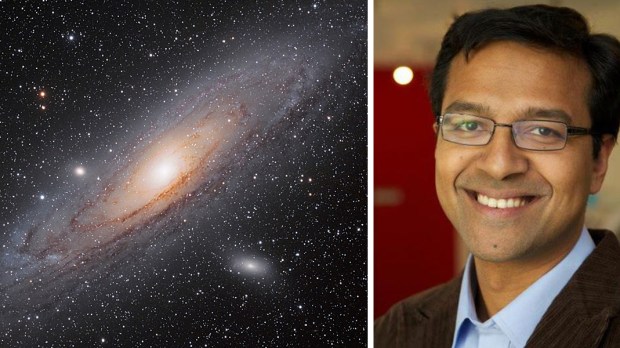Lenten Campaign 2025
This content is free of charge, as are all our articles.
Support us with a donation that is tax-deductible and enable us to continue to reach millions of readers.
A galactic halo is a component of a galaxy that extends beyond the main, visible component. In laymen’s terms it is the colorful spherical shape that surrounds the flat disk of a spiral galaxy. While a halo in a painting is an indicator of holiness, galactic halos can offer valuable clues to a galaxy’s multi-billion-year history.
Jesuit Father Richard D’Souza, a post-doctoral researcher at the University of Michigan since 2016, has made a study of these halos in order to better understand the evolution of galaxies. In particular, he has focused his research on the Andromeda Galaxy, designated as M31 in French comet hunter Charles Messier’s catalog of astronomical objects — our own Milky Way’s neighbor.
Father D’Souza and fellow University of Michigan astronomer Eric Bell published a paper last July, in the journal Nature Astronomy, with the hypothesis that Andromeda absorbed another galaxy, one that was the third largest member of our Local Group (a cluster of galaxies). This devouring would have been a process that took three to four billion years.
Father D’Souza said that clues of this cannibalism came from stars in Andromeda that had a higher proportion of metallicity — elements heavier than hydrogen and helium. These proportions match the chemical compositions of stars in the remnants of M32.
The study has had mixed reactions within the astronomy community. Father D’Souza told Catholic News Service:
“I have been going around actually giving talks on this at various (astronomy) departments,” Father D’Souza said. “Once they see the evidence, they say, ‘Wow, this is great.’ Up until then they don’t see it.”
Bell shrugged off the mixed reactions, claiming they did not matter. He said that working so closely with Father D’Souza was a valuable educational experience in its own right. He also noted that whether his peers agreed or disagreed with his findings, the paper has served to spread Father D’Souza’s name more widely.
Jesuit Brother Guy Consolmagno, director of the Vatican Observatory echoed the sentiment, telling Catholic Philly:
“Now he’s well enough established in research that he could do it anywhere,” Brother Consolmagno said.
Father D’Souza is set to join Brother Consolmagno in the Vatican Observatory when he finishes the three-year program at the University of Michigan. The position will be the realization of a long time dream of the Indian-born priest, who knew even as a child that he wanted to work in the Vatican Observatory.
“He’s someone we’ve known for 20 years,” Brother Consolmagno told CNS. “He’s brilliant. He’s one of the smartest guys we’ve had come along in a long time.”
When Father D’Souza is not poring over star charts or stooping over a telescope, he devotes himself to his ministry. He celebrates Mass on weekends at St. Mary Student Parish, a few blocks from campus. He described himself as immersed in the liturgy and says he spends hours each week perfecting his homilies.
Father D’Souza is excited to start work at the Vatican Observatory. He says that he considers his scientific work to be complementary to his priestly efforts. He sees each as a call to search for meaning and understanding in God’s creations. He sees no conflict between science and the Catholic faith:
“We’re looking for something beyond us,” he said, citing Jesuit Father Karl Rahner. “The most transcendental thing you can have is God. … Astronomy is the most transcendental of the sciences and yet most physical, and that is the reason perhaps it has long fascinated everyone in history.”

